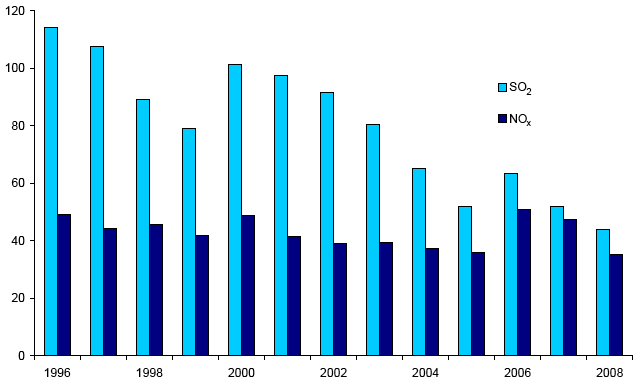Key Scottish Environment Statistics 2009
Annual publication containing summary of key statistics on environmental trends in Scotland
Air Quality
Emissions of sulphur dioxide and nitrogen oxides from large combustion plants R,8: 1996-2008
Annual LCP emissions (thousand tonnes)

Annual emissions (thousand tonnes)
SO 2 |
NO X |
|||||||
|---|---|---|---|---|---|---|---|---|
Source |
1996 |
2000 |
2007 |
2008 9 |
1996 |
2000 |
2007 |
2008 9 |
Electricity supply |
99.1 |
93.2 |
47.0 |
39.5 |
44.7 |
42.6 |
39.4 |
29.1 |
Refinery |
11.3 |
6.0 |
2.7 |
2.2 |
2.9 |
2.9 |
3.6 |
2.1 |
Other industry |
3.8 |
2.3 |
2.4 |
2.2 |
1.5 |
3.4 |
4.4 |
3.9 |
Sulphur dioxide (SO 2) and oxides of nitrogen (NO X) affect human health through respiratory damage, and ecosystem health through acidification. SO 2 and NO X are released into the atmosphere through the combustion of fossil fuels. In 2006, large combustion plants ( LCPs) accounted for 54% of the SO 2 emissions and 24% of NOx emissions in the UK. 3
The Large Combustion Plants Directive (since revised by 2001/80/ EC) called for a 60% reduction in SO 2 emissions by 2003 and a 30% reduction in NO X emissions by 1998, from a 1980 baseline. By 2002, UK emissions for SO 2 and NOx were 78% and 64% respectively below 1980 levels 3. In Scotland, SO 2 emissions from the electricity supply industry fell between 1996 and 1999, but rose in 2000. This was due to the increased use of coal-fired power stations, necessary to offset the reduced capacity of the nuclear sector because of refurbishment work at certain plants.
In 2008 emissions of SO 2 and NOx decreased by 16% and 26% respectively since 2007. This second consecutive year of reductions means that SO 2 and NOx emissions are now at the lowest they have been since records began in 1996. The large rise in 2006 was due mainly to increased emissions from the electricity supply sector, and specifically to the increased use of coal.
There is a problem
Thanks for your feedback